Protecting Airport Data Privacy & Control from Cyber Threats: Navigating GDPR
 1 February 2024
1 February 2024? Listen to the Summary of this article in Audio
The aviation industry is a crucial global linchpin in today’s interconnected world, connecting people, cultures, and businesses across continents. Research conducted by MIT and highlighted on their news website illustrates the increasing importance of air transport in connecting regions worldwide. This is underscored by the analysis of 1.2 million ticketed flight itineraries and flight schedules at over 4,600 airports, which specifically help properly construct, a “global connectivity index” score for each airport. This score reflects an airport’s connectedness to the global air transport network. The research found that global nonstop and one-stop connectivity, initially concentrated at North American airports, has become more dispersed globally, especially with the rise of Asian and European markets.

The MIT research underscores the aviation industry’s immense global interconnectivity, which brings tremendous benefits, enabling cross-continental travel and commerce. However, it also creates complex cybersecurity challenges. Every flight generates and transmits an enormous volume of sensitive data, including passenger data, flight plans, navigation data, and aircraft sensor readings. The analysis and operation of modern aircraft rely heavily on advanced networked systems and real-time data, including the processing of personal data. While this interconnectivity enables the incredible capabilities of modern aviation, it also introduces cyber vulnerabilities that could have dire consequences if exploited. The industry’s reliance on emerging technologies like cloud computing and wireless networks to transmit and store data presents further cyber risks. This vast, integrated digital infrastructure supports the aviation industry but also creates an attack surface for malicious actors. Consequently, as aviation continues to capitalize on technological innovation, cybersecurity must be at the forefront to secure data and critical systems against evolving threats in an interconnected world.

The aviation sector, encompassing vast operations from airline management to airport logistics, increasingly relies on sector stakeholders to proactively contact digital technologies. This reliance makes cybersecurity a paramount concern. Data must be protected with utmost diligence in this digital landscape, and aviation sector stakeholders should proactively contact cybersecurity experts to address potential vulnerabilities and strengthen their defense systems. The rise of cyber threats, including sophisticated phishing attacks, ransomware, and advanced persistent threats (APTs), highlights the urgent need for robust cybersecurity measures.
The Landscape of Aviation Cybersecurity Threats
In aviation, the landscape of cybersecurity threats is as dynamic as it is daunting. As the industry increasingly adopts digital systems to enhance efficiency and passenger experience, it concurrently exposes itself to protecting cyber threats. The challenges the aviation sector faces in terms of cybersecurity are multifaceted, primarily revolving around safeguarding critical data and maintaining the integrity of operational systems.
One of the most significant challenges is the sheer volume and variety of data the aviation industry handles. This data ranges from passengers’ data to sensitive operational information. The stakes of protecting this data are exceptionally high, as any compromise could lead to severe privacy violations, financial losses, or even risks to passenger safety. Airports, serving as central nodes in the aviation network, are particularly vulnerable due to the extensive data they collect and process.
Another critical challenge is the interconnected nature of aviation systems. Every component is a potential entry point for cyber threats, from air traffic control communications to in-flight entertainment systems. Integrating these systems enhances operational efficiency and creates complex cybersecurity challenges, where a breach in one system can have cascading effects.
Case Studies: Cyberattack Airplane Vulnerabilities and Recent Incidents
To understand the real-world implications of these threats, it is instructive to examine recent incidents and case studies of cyberattacks in the aviation sector.

Airport Data Breach Incident
One notable incident involved a major international airport, where a cyberattack led to unauthorized access to passenger data. According to a report published by BBC, British Airways experienced a significant data breach in 2018, where personal data relating to 429,612 customers and staff, including names, addresses, and credit card information, was stolen. This incident resulted in a record-breaking fine of £20 million from the Information Commissioner’s Office for failing to protect customer data under GDPR. Similarly, Cathay Pacific faced a breach impacting 9.4 million accounts, leading to the theft of extensive personal data and resulting in a fine of £500,000.
Air Traffic Control System Hack
Another incident saw hackers infiltrating an air traffic control system. According to the reports, the Federal Aviation Administration’s (FAA) information security program was at risk of being hacked. These vulnerabilities were highlighted in a Government Accountability Office (GAO) audit report. As per the reports, the FAA was responsible for overseeing the development of the air traffic control system, which includes more than 19,000 airports and approximately 600 air traffic control facilities. The report pointed out that despite steps taken by the FAA to protect its air traffic control systems from cyber threats, there remained significant security control weaknesses that threatened the safe operation of the national airspace system.
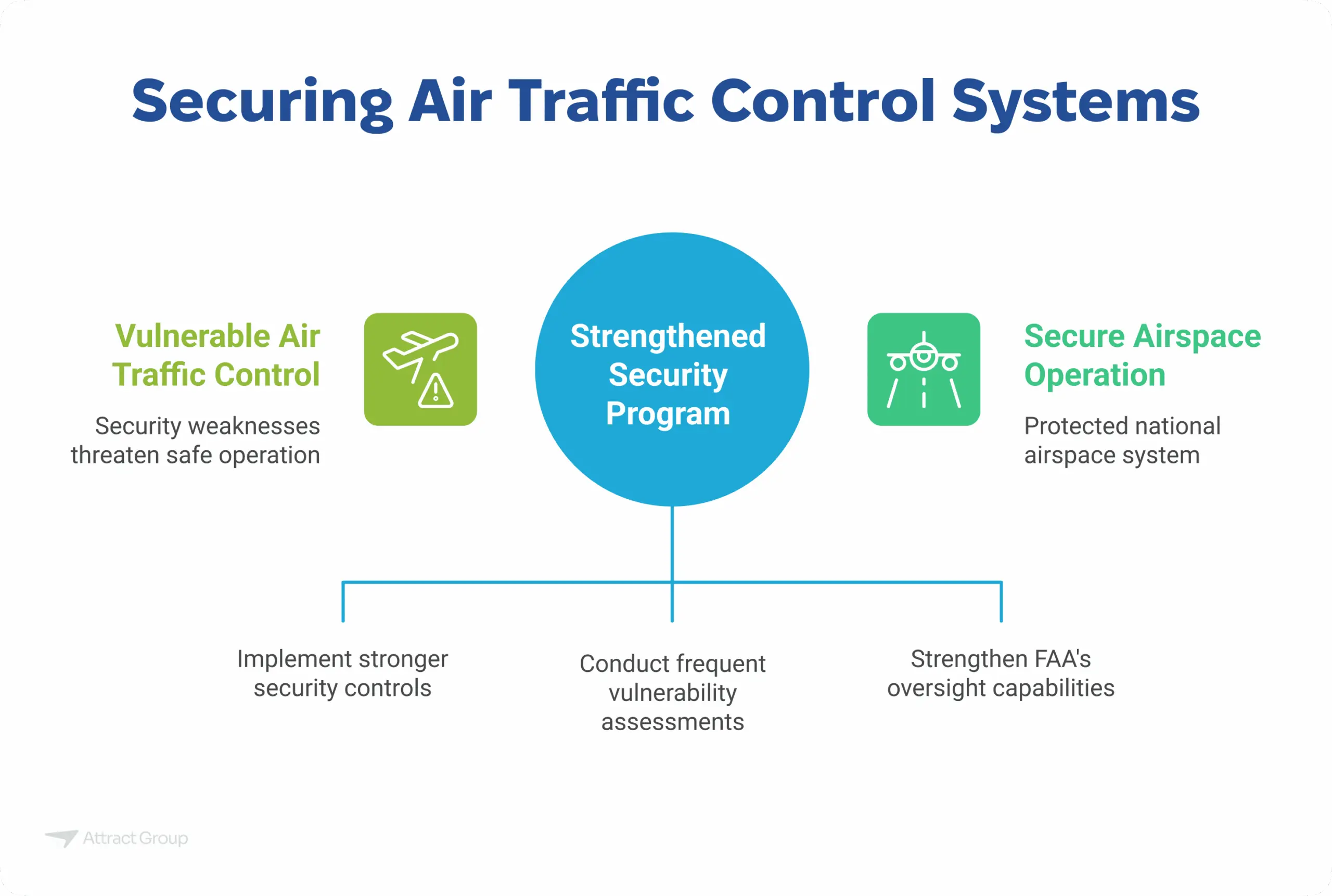
In-Flight Entertainment System Vulnerability
A less dangerous but still concerning incident involved an airplane’s in-flight entertainment system vulnerabilities. Hackers demonstrated that it was possible to access this system, raising concerns about the broader security of the aircraft’s network. While no serious consequences resulted from this incident, it served as a wake-up call about the potential for more severe attacks.
Partner with our experts to assess vulnerabilities and implement robust protections tailored to your unique infrastructure.
Regulatory Framework and Compliance
The General Data Protection Regulation (GDPR) is one of the most significant airport data privacy and cybersecurity regulations. GDPR sets stringent guidelines for processing and handling personal passenger data. To comply, airports and airport stakeholders must implement robust strategies, including establishing protocols for collecting, processing, storing, and disposing of passenger data as per GDPR mandates. This also involves conducting regular data audits and impact assessments to identify and mitigate risks, ensuring data access is limited to authorized personnel only, and being equipped to respond to passenger data requests.
Aviation cybersecurity regulations also require comprehensive measures to protect systems from threats and security breaches while balancing safety and privacy concerns. This requires securing communication networks and flight control systems, adhering to cybersecurity standards outlined by the International Air Transport Association (IATA) and the International Civil Aviation Organization (ICAO), and continuously assessing and adapting to meet evolving legal cybersecurity requirements. A nuanced, evolving approach is essential to address robust cybersecurity and respecting passenger privacy rights.
Data Protection Strategies in Aviation
Implementing effective data protection strategies is crucial in aviation’s fast-paced and data-intensive environment. Airports, serving as critical nodes in the aviation network, face the daunting task of protecting vast amounts of sensitive data against escalating cyber threats. To this end, deploying robust data protection requirements within airport systems is not just a regulatory mandate but a fundamental necessity for operational integrity and passenger trust.
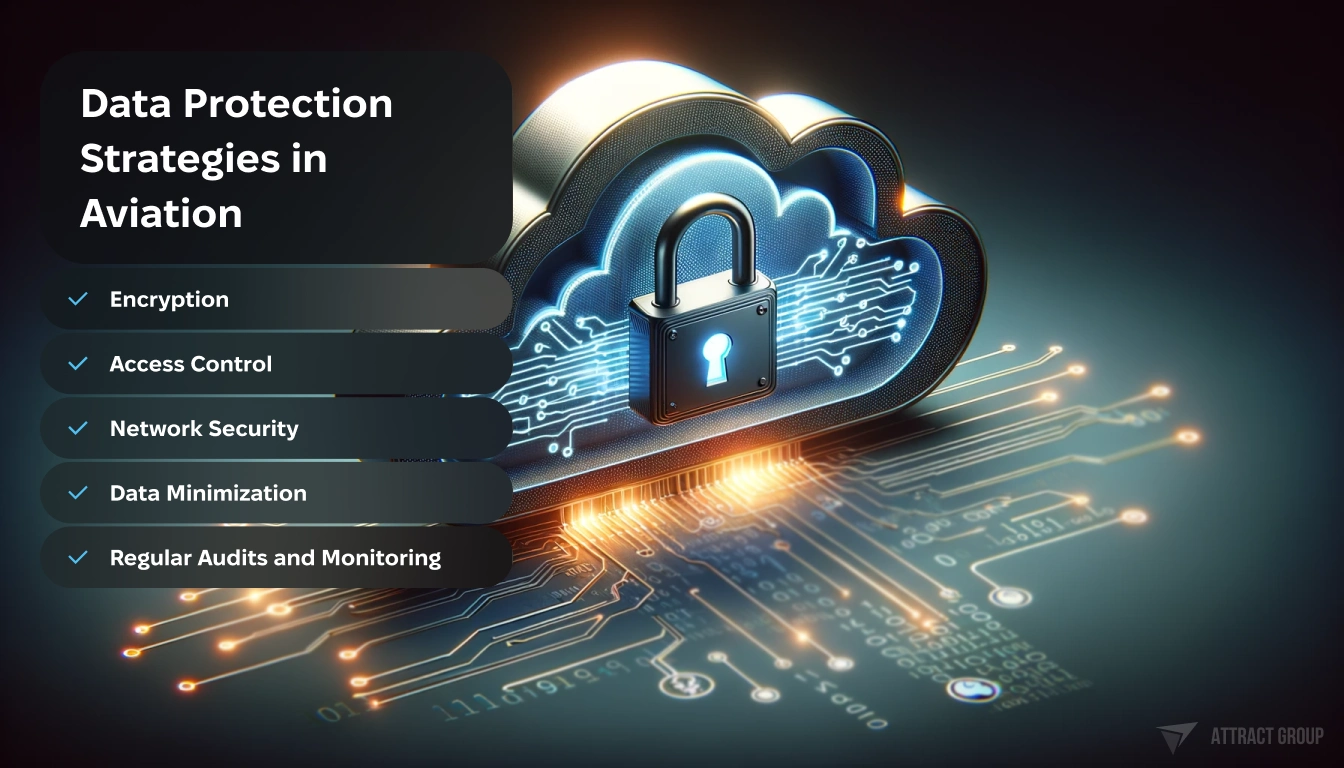
Adopting a multi-layered security approach is the cornerstone of adequate data protection in airport systems. This involves implementing technical and organizational measures designed to safeguard data at every level of the airport’s operations. Key components include:
- Encryption: Encrypting sensitive data at rest and in transit is vital. This ensures that even if data is intercepted or accessed without authorization, it remains unintelligible and useless to attackers.
- Access Control: Implementing strict access control measures is essential. This means ensuring that only authorized personnel have access to sensitive data and that access rights are granted based on the principle of least privilege.
- Network Security: Robust network security protocols, including firewalls and intrusion detection systems, protect against unauthorized access and cyber threats.
- Data Minimization: Airports should collect only the data necessary for the intended purpose and nothing more. This practice limits the potential impact of a data breach.
- Regular Audits and Monitoring: Regularly monitoring airport systems for unusual activities and regular audits help in the early detection and mitigation of potential security issues.
Leverage our experience to implement layered data protection strategies that comply with regulations and ensure passenger trust.
Passenger Data Protection: Techniques and Importance
The protection of passenger data holds paramount importance in the aviation industry. This data includes basic personal information, legal requirements, and often sensitive details such as travel itineraries, payment information, and sometimes biometric data. Protecting this data is a legal requirement and critical to maintaining passenger trust and the industry’s reputation.
To protect passenger data, airports and airlines employ various techniques, including:
- Data Anonymization and Pseudonymization: Data should be anonymized or pseudonymized wherever possible. This reduces the risks associated with data processing and storage.
- Data Segregation: Keeping passenger data segregated from other operational data can limit the risk of widespread data exposure in a breach.
- Phishing and Social Engineering Training: Staff training is crucial as human error often leads to data breaches. Training employees to recognize phishing attempts and social engineering tactics is essential.
- Incident Response Plans: Having a well-defined incident response plan ensures that in the event of a data breach, the airport can swiftly mitigate damages and notify affected individuals.
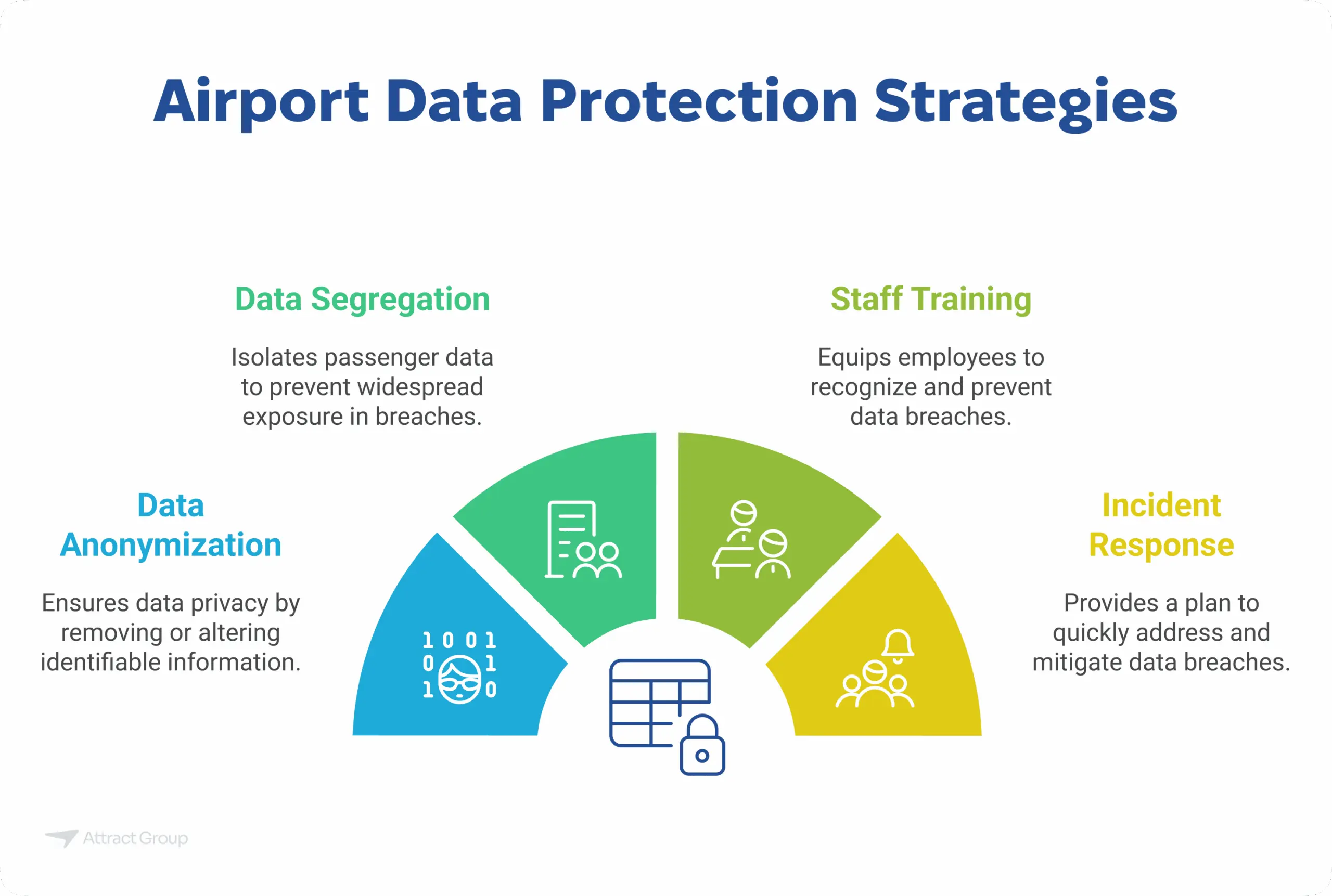
Best Practices for Enhancing Airport IT Security
In the digital age, airport IT security has become a critical aspect of airport operations, demanding continuous enhancement and vigilance. Given the complexity and sensitivity of the data handled and the sheer scale of airport infrastructures, building robust IT security protocols is essential for safeguarding against potential cyber threats. Regular international airport reviews of existing IT security measures by external experts can help identify any vulnerabilities or gaps that must be addressed through updated protocols, technologies, and staff training. With increasingly sophisticated cyberattacks, maintaining state-of-the-art IT security is crucial for airports to protect their digital assets and ensure seamless operations.
The development of comprehensive IT security protocols in airports involves several key components:
- Layered Defense Strategy: A layered or “defense-in-depth” approach is vital. This strategy employs multiple layers of defense at various points in the airport’s IT infrastructure, ensuring that even if one layer is compromised, additional layers of security are in place to protect the system.
- Regular Software Updates and Patch Management: Keeping all software and systems updated with the latest security patches is crucial. Cyber attackers often exploit vulnerabilities in outdated software, making regular updates a frontline defense against breaches.
- Secure Network Architecture: Designing a secure network architecture is critical. This involves segregating essential segments of the network, controlling access points, and ensuring that sensitive areas of the network are insulated from potential breach points.
- Robust Authentication Processes: Implementing vital authentication processes, including multi-factor authentication, helps verify the identity of users accessing the system, thus preventing unauthorized access.
- Employee Training and Awareness: Regular training sessions for airport staff on the latest cybersecurity threats and best practices are essential. Staff should be educated on the importance of security protocols and their role in maintaining them.
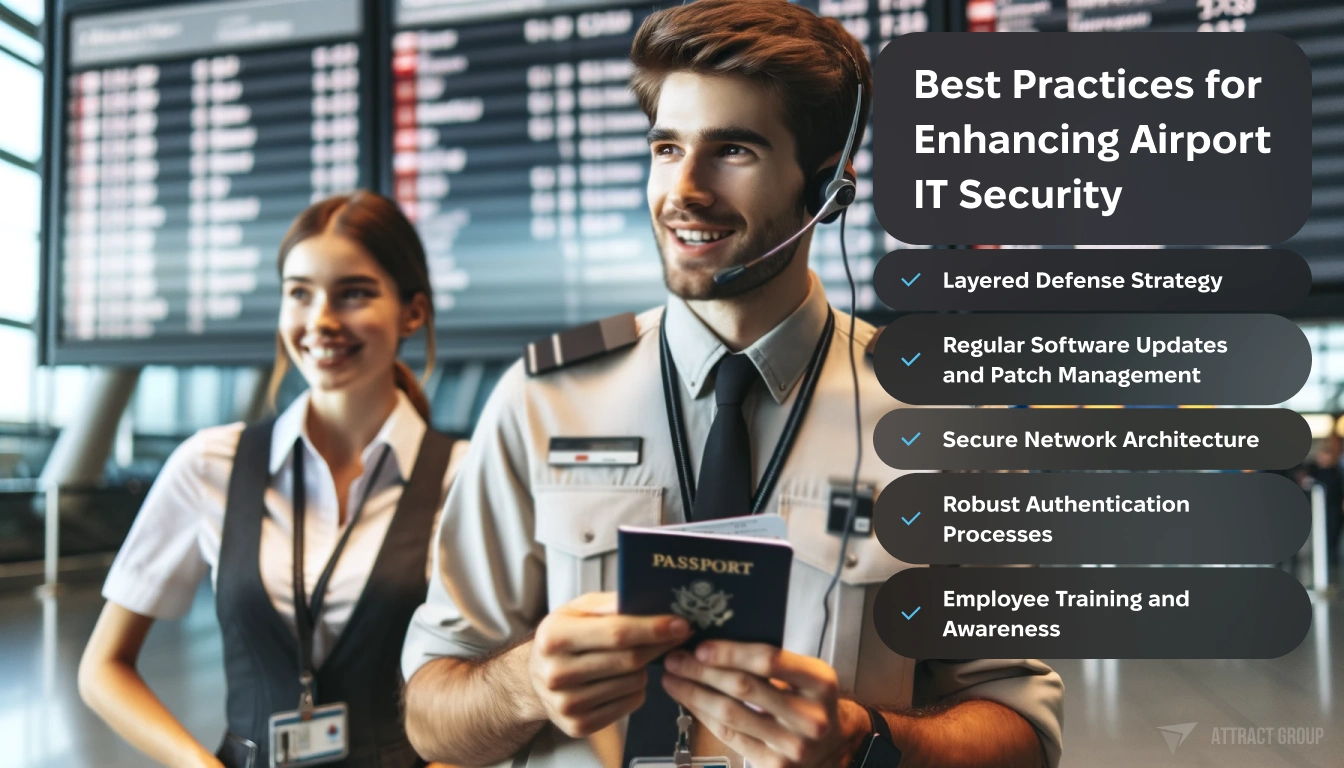
Incorporating Breach Detection Software to Stop Airport Security Breach
In addition to building robust IT security protocols, incorporating advanced breach detection software is critical in enhancing airport cybersecurity. Breach detection software plays a pivotal role in identifying and responding to security incidents before they escalate into significant breaches.
Key aspects of effective breach detection software include:
- Real-Time Monitoring: The software should provide real-time monitoring of the airport’s network, analyzing traffic and activities for potential threats.
- Anomaly Detection: It should be capable of detecting anomalies in network behavior, which could indicate a breach or an attempted attack.
- Automated Alerts: Upon detecting a potential threat, the software should generate automatic alerts, enabling quick response from the IT security team.
- Integration with Existing Systems: The software should integrate seamlessly with the airport’s security infrastructure, enhancing the overall effectiveness of the cybersecurity strategy.
- Forensic Capabilities: Post-breach analysis capabilities are essential for understanding how a breach occurred and improving future security measures.
Advanced Security Measures for Airport Operations and Privacy
In the complex operational environment of airports, communication systems play a crucial role. These systems, ranging from air traffic control communications to internal coordination networks, are vital for the smooth functioning of airport operations. However, they also represent potential vulnerabilities if not adequately secured. Implementing secure airport communication systems is thus critical to data safeguarding and overall cybersecurity.
Securing these communication systems involves several vital strategies:
- Encryption: Implementing end-to-end encryption for communications is fundamental. This ensures the information remains secure and unintelligible to unauthorized parties even if the communication is intercepted.
- Network Segmentation: By segmenting networks, airports can isolate critical communication systems from other less sensitive networks. This limits the spread of potential breaches and reduces the risk of compromised essential communication systems.
- Regular System Audits and Monitoring: Continuous monitoring of communication systems for unusual activities or vulnerabilities is essential. Regular audits help identify potential security gaps and implement timely remedies.
- Access Control and Authentication: Ensuring that only authorized personnel have access to communication systems and implementing robust authentication methods are crucial for preventing unauthorized access.

Biometric Data and Airport Access Control Systems: A Double-Edged Sword
Using biometric data in airport access control systems represents a significant advancement in ensuring security and efficiency. Biometric systems, using unique physical characteristics like fingerprints or facial recognition for identification, provide a highly secure and efficient method of controlling access to sensitive airport areas. However, this technology is a double-edged sword regarding data protection and privacy.
| Advantages of Biometric Access Control | Concerns Regarding Biometric Data |
|---|---|
| Enhanced Security: Biometrics provide reliable identity verification, reducing unauthorized access risks. | Privacy Issues: Biometric data collection/storage raises substantial privacy issues. Compliance with data protection laws/regulations is critical. |
| Operational Efficiency: Streamlined access control process reduces wait times and improves airport efficiency. | Data Security: Biometric data is susceptible. Securing it against breaches is paramount. |
| User Convenience: Biometric systems offer a quick, user-friendly experience, eliminating the need for passwords or ID cards. | Dependency on Technology: Over-reliance on technology can be risky if systems fail. Alternative security is needed. |
Secure Cloud and Encryption Solutions
In the ever-evolving landscape of airport operations, cloud computing has emerged as a transformative technology. It offers vast opportunities for improving efficiency and scalability in data management. However, integrating cloud solutions into the complex airport operations ecosystem brings challenges, especially concerning security.
| Opportunities in Cloud Computing for Airports | Challenges in Cloud Security |
|---|---|
| Enhanced Scalability and Flexibility: Cloud solutions enable airports to handle growing data volumes efficiently via flexible scaling of resources without physical infrastructure constraints. | Data Security Risks: Storing sensitive data in the cloud poses risks. Airports must ensure cloud platforms offer robust security measures against data breaches and cyber threats. |
| Cost Efficiency: Migrating to cloud platforms can reduce data storage and management costs, enabling more effective resource allocation. | Regulatory Compliance: Airports must comply with data protection regulations like GDPR. Ensuring cloud services adhere to these regulations is vital for legal compliance and passenger trust. |
| Improved Data Accessibility and Backup: Cloud services provide better accessibility to data across departments, along with reliable backup/recovery systems crucial for mission-critical operations. | Reliance on Third-party Providers: Using cloud services means depending on third-party providers. Careful vendor selection and monitoring are essential to ensure consistent security standards. |
Data Encryption in Airport Systems: Ensuring Confidentiality and Integrity
Data encryption is a cornerstone of cybersecurity in airport systems. As airports collect and process vast amounts of sensitive data, ensuring the confidentiality and integrity of this data is paramount. Encryption serves as a critical tool in achieving this goal.
Critical Strategies for Data Encryption in Airports:
- Encryption of Stored Data (Data-at-Rest): Encrypting data stored in airport databases and cloud platforms is essential to protect it from unauthorized access.
- Securing Data in Transit: Data exchanged over networks, whether internally or with external agencies, must be encrypted to prevent interception and ensure secure communication.
- Key Management: Effective encryption relies on robust key management. Airports must have secure systems for generating, storing, and managing encryption keys.
- Comprehensive Implementation: Encryption should be applied to select data sets and comprehensively across all sensitive data handled by the airport. This includes passenger information, operational data, and communications.

Work with our team to integrate the latest technologies and strategies to future-proof your systems against emerging threats.
Training and Awareness: The Human Factor
At the core of strengthening aviation cybersecurity is recognizing the critical role played by the human element. Airport staff, from security personnel to administrative employees providing airport services, play a pivotal role in maintaining the overall cybersecurity posture of the airport. Therefore, comprehensive cybersecurity training for all staff is essential for building a resilient and security-conscious culture.
Regular ongoing training programs are from ensuring staff are up-to-date on the latest cybersecurity threats and best practices across topics from basic digital hygiene to advanced threat detection. Conducting simulated cyber-attack scenarios can reinforce threats’ practical implications and the importance of prevention. The importance of prevention Frequent awareness campaigns about data security and potential breach impacts can foster heightened responsibility. An environment that encourages reporting of suspicious activities or lapses, with swift action on reports, enables early threat detection.
Overall, comprehensive training, practical exercises, awareness drives, and a reporting culture empower airport staff to become a solid first line of defense against cyberattacks. An informed, vigilant, and responsive workforce is indispensable in aviation cybersecurity. Investing in human capital is critical to cultivating organizational resilience.
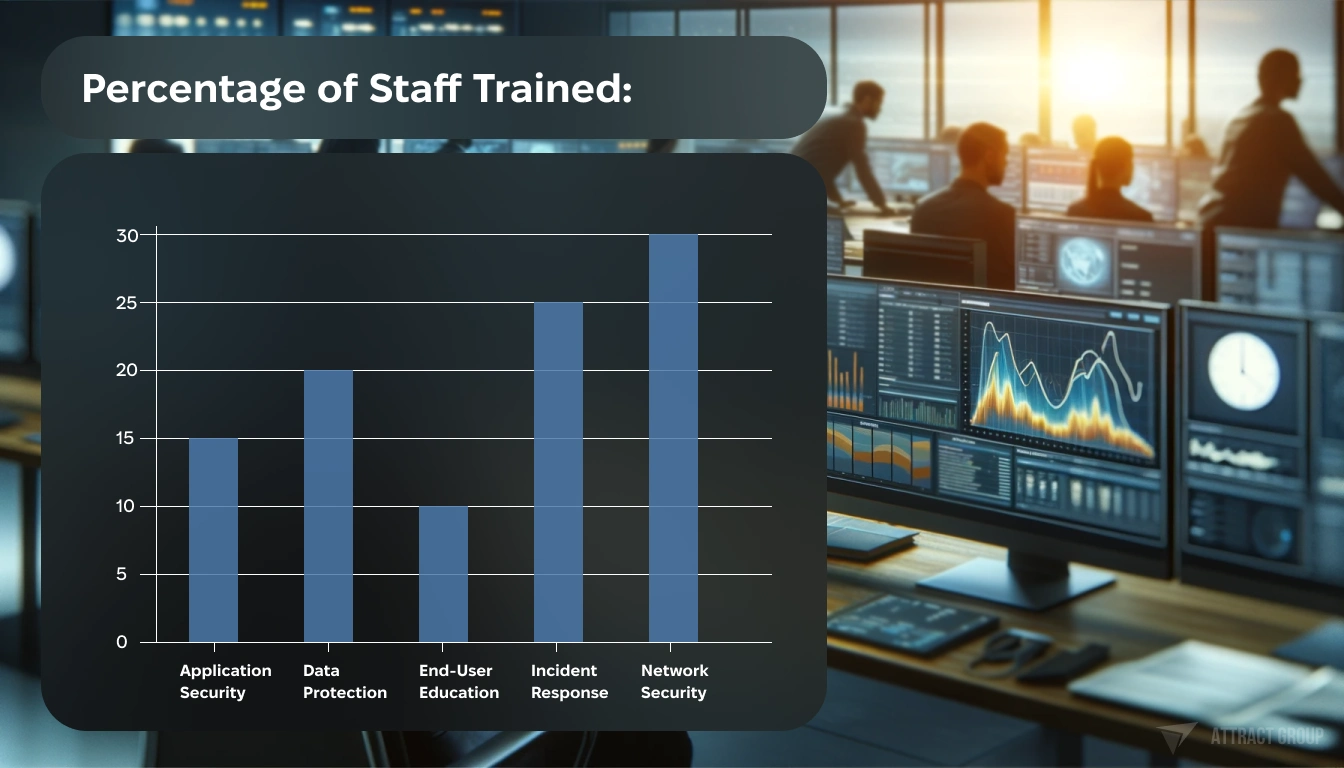
Role of Data Protection Officers in Aviation: Leadership in Data Security
The appointment of Data Protection Officers (DPOs) in aviation plays a significant role in steering the data security efforts of airports. DPOs, often mandated by regulations like GDPR, oversee data protection strategy and implementation, ensuring compliance with data protection laws.
Responsibilities and Impact of Data Protection Officers:
- Policy Development and Implementation: DPOs are tasked with developing comprehensive data protection policies tailored to the specific needs and risks of the airport. They ensure that these policies are implemented effectively across all departments.
- Compliance Monitoring: Regular monitoring and auditing of data processing activities are essential duties of DPOs. They ensure that the airport’s data handling practices comply with legal standards.
- Staff Training and Awareness: DPOs play a crucial role in organizing training and awareness programs for staff. They ensure that employees understand the importance of data protection and are equipped to comply with the policies.
- Incident Response and Reporting: In the event of a data breach, DPOs are responsible for managing the response, including coordinating with relevant authorities and stakeholders. They also ensure that legal requirements report breaches.
- Advisory Role: DPOs act as advisors to the airport management on all matters related to data protection. They stay informed about the latest developments in data protection laws and technologies to provide strategic guidance.
Incident Response and Continuity Planning
In airport operations, where data breaches can have severe implications, having a well-structured incident response plan is not just a precaution; it’s a necessity. An effective incident response plan ensures that airports are prepared to quickly and efficiently manage data breaches involving different data, minimizing potential damages and restoring normal operations as swiftly as possible.
A robust, data-driven incident response plan will enable rapid detection of a breach and immediate assessment of its scope and impact. This requires robust monitoring systems and a trained response team ready for prompt action. The plan should delineate the roles and responsibilities of various teams and individuals during a breach to ensure a coordinated and effective response. Effective communication protocols, both internal and external, are also crucial so that stakeholders, regulatory bodies, and potentially affected individuals can be informed as per legal and regulatory mandates.
Upon detecting a breach, the plan should enable the containment of the incident and mitigation of impact through immediate countermeasures like isolating affected systems, revoking access, etc. Steps for recovering compromised systems, ensuring data remains secure and protected, and restoring normal operations after addressing vulnerabilities must also be outlined. Once the incident has been managed, a thorough post-incident analysis should be conducted to understand the breach’s cause, gauge the efficacy of the response, and derive crucial lessons for the future.
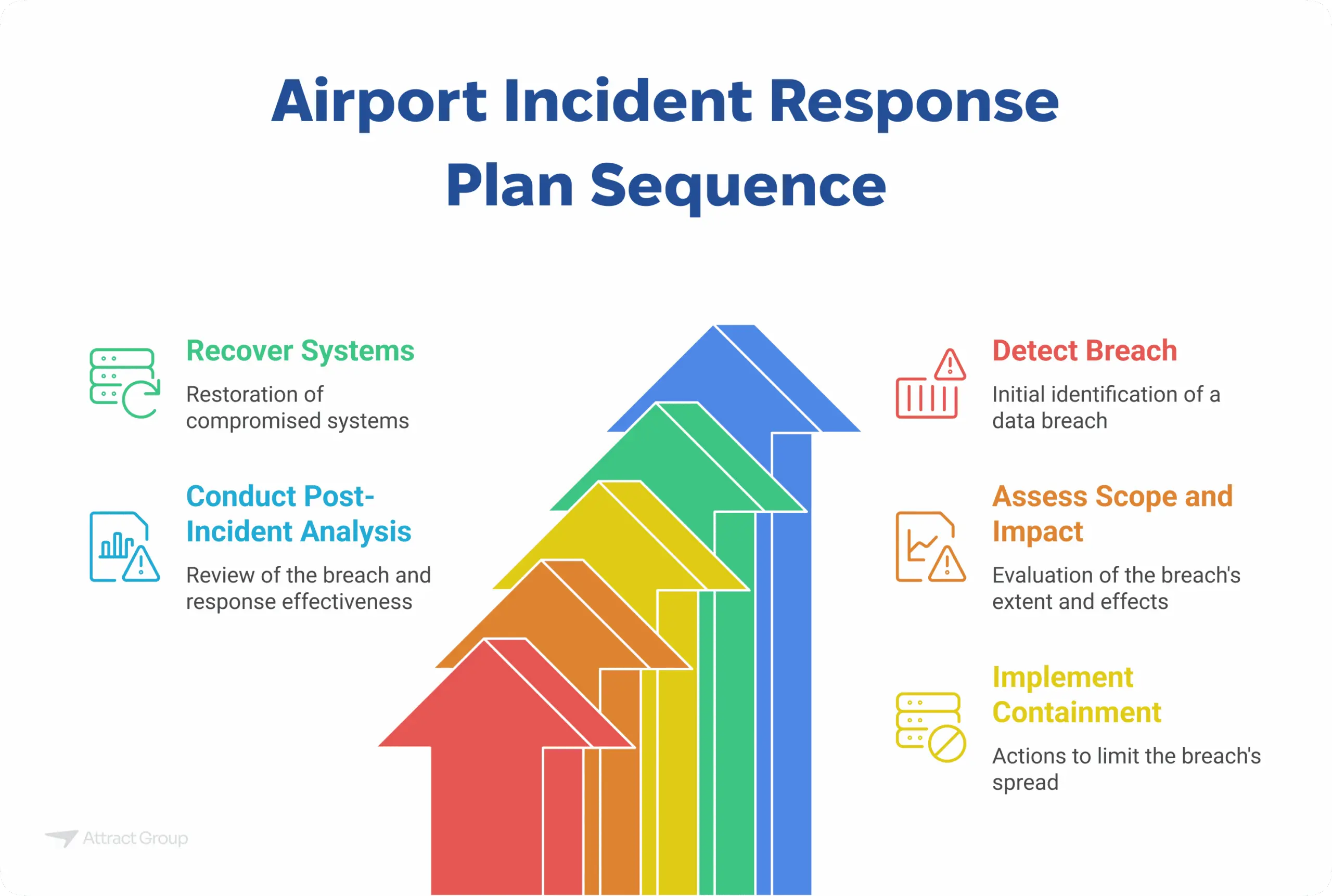
By incorporating these key elements, an airport can structure a detailed incident response plan that will prove invaluable in enabling swift and efficient responses to data breaches involving raw data, minimizing disruptions and damages. A well-formulated plan is an airport’s critical first line of defense against the havoc a data breach can wreak.
Data Protection Impact Assessments (DPIA) for Airports
Data Protection Impact Assessments (DPIAs) are essential for airports to manage the risks associated with data processing activities proactively. DPIAs help identify and minimize data protection risks, particularly for new projects or changes in operations involving personal data processing.
Importance and Process of DPIA in Airports:
- Early Risk Identification: Conducting DPIAs helps identify potential data protection risks at an early stage, allowing for the timely implementation of mitigating measures.
- Compliance with Legal Requirements: For airports, especially in regions governed by GDPR, DPIAs are often a legal requirement for high-risk data processing activities.
- Engagement with Stakeholders: DPIAs involve consulting with relevant stakeholders, including data protection officers, security teams, and potentially affected parties, ensuring a comprehensive assessment of risks.
- Documentation of Compliance: DPIAs provide documented evidence of the airport’s commitment to data protection and compliance with legal obligations.
- Continuous Improvement: Regularly updating DPIAs in response to changes in data processing or emerging threats ensures continuous improvement in data protection practices.
Future of Aviation Cybersecurity
As we peer into the future of aviation cybersecurity, it’s clear that the field is poised for significant evolution, driven by emerging technologies and shifting threat landscapes. The aerospace industry is increasingly embracing digital innovation, which, while opening new horizons in efficiency and passenger experience, also brings novel cybersecurity challenges. As airlines often process personal data on behalf of airports, enhancing data protection will be an essential focus area.

Artificial intelligence and machine learning are set to play a pivotal role in enhancing cybersecurity in aviation. These technologies can analyze patterns, detect anomalies, and predict potential threats more accurately and quickly than human operators. Blockchain technology also promises to ensure data integrity and traceability of flight information, maintenance records, and passenger data while the distribution of passenger data remains secure. However, quantum computing presents both a challenge and an opportunity, with its potential to break traditional encryption methods. The industry is preparing for post-quantum cryptography to safeguard against future threats. As airports and airplanes become more connected with IoT devices, enhanced IoT security protocols will be critical to protect against vulnerabilities.
The future demands evolving aviation threat management strategies beyond just embracing new technologies. Proactive threat intelligence through continuous monitoring and predictive analytics will be essential to stay ahead of emerging risks. Collaborative security frameworks strengthening industry-wide cooperation are necessary for robust measures. Regularly updating protocols to match new threat landscapes, extensive training and awareness programs, building organizational resilience, and having incident response plans will also be crucial.
By adopting a forward-thinking, agile approach, the aviation industry can continue to drive innovation while actively shaping the future of cybersecurity. The focus must be on collective preparation, vigilance, and resilience to navigate the challenges of tomorrow.
Conclusion: Safeguarding the Skies
As we conclude our exploration of aviation cybersecurity, it’s clear that safeguarding the skies in the digital age is a complex and ongoing journey. Within the airport, a significant amount of data is collected from airline passengers during various processes like ticket booking, check-in, security checks, etc. This includes sensitive personal data like travel details, contact information, identification details, financial data, etc. Proper data protection and management are crucial, as any security breach can compromise customer data. Under regulations like the EU General Data Protection Regulation, airports must implement robust cybersecurity protocols and comply with international data protection laws when collecting, processing, and storing passenger data.

Airport operators act as data controllers, while airlines often take on the role of data processors who handle data processing on the controller’s behalf. Both parties must protect customer data through encryption, access controls, and compliance audits. Confidential data must be secured against threats of theft or misuse. Data retention and distribution protocols must ensure passenger data remains secure.
Advanced threat detection systems, secure network architecture, multi-factor authentication, and regular cybersecurity training for airport staff enhance aviation cybersecurity. As airports become increasingly digitalized and e-commerce-oriented, the attack surface becomes e-commerce-oriented. Hence, proactive governance through measures like data protection impact assessments and embracing emerging technologies like AI properly is prudent.
Let’s partner to assess your infrastructure, identify risks, and implement robust cybersecurity tailored to your needs.
The aviation industry must foster a culture of resilience through collaborative approaches, continuous research, and upgrades. With persistent efforts, cybersecurity awareness, and a commitment to data protection, the sector can continue to innovate while keeping customer data and airport operations secure.










